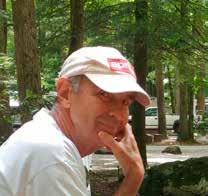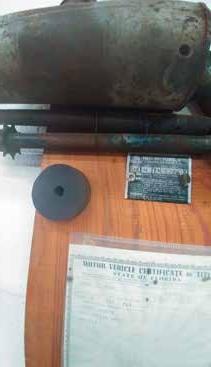
5 minute read
Chairman of the Board
A couple of years ago, AHRMA's Leadership laid out a three-year plan. Even though AHRMA has been doing pretty well in recent years, there were things in our operation that were in need of attention. Some things were big, and some were small.
Year one of the plan was to set a foundation by getting our house in order. Some of the items were: improving our membership and race entry software, updating our accounting, streamlining the annual voting process, and breaking down some perceived internal barriers. That was 2019. Year two, 2020, was to be the transition year where we developed plans to meet the needs and requests of members. Our goals included such items as promoting multi-discipline events, racing at higher profile racetracks, creating a marketing infrastructure, and enhancing vintage classes. With a big effort from AHRMA's staff, board of trustees, and amazing team of volunteers (y'all know who you are, and thank you) we not only weathered the storm of 2020, but accomplished many of our transition year goals. Some work still to do. Year three was intended to be the crescendo year, where the plans come together.
Longtime AHRMA members reminisce fondly about the old Steamboat Springs multi-discipline events, as if it was Woodstock. We hope to capture some of that magic with our AHRMA Classic MotoFest (multidiscipline vintage motorcycle festivals) on Memorial Weekend at Heartland Motorsports Park in Kansas, and then again at the second Motofest in midJuly at California's Laguna Seca Raceway.
Also, this year we will launch a tribute to Dick Mann, one of America's all time multi-discipline racing heroes. The 'Dick Mann National Team Championship' already has in place five teams of five riders (one rider from each discipline, per team) who will race for points throughout the season. How closely contested will they be? Will the championship come down to the 2021 Barber Vintage Festival in October? How many teams will still be in the hunt by then?
AHRMA has been an exciting organization for a long time, but is still a bit of a secret. This year we let the rest of the world see how much fun we are having, encouraging others to bring out their eclectic motorcycles and join our club.
Let's get this season rolling (and thanks for the votes re-electing me to the board of trustees)!
See y'all at the track.
Arthur Kowitz
My First Motorcycle
Like so many early teenagers, the idea of riding a motorcycle fascinated me to the point of distraction. Also, like many of our parents in 1963, permission to fulfill this dream was out of the question. My folks were prudent, intelligent people who wanted only the best for me, and since they were not thrill-seekers, the whole motorcycle idea was incomprehensible to them. “No, you can’t have or ride a motorcycle!” ”If I build one, can I keep it and ride it?”
As realistic adults, they knew that was impossible, so they granted permission based on the expectation that such an undertaking was merely a dream. Ha! Have bicycle—will travel. I combed every junk pile behind bicycle shops, lawnmower shops, appliance stores, and anywhere else free machinery-like items might be found. Some of the engineering decisions were based upon what items had been commandeered, and some were the well-thought-out plans of an inexperienced 13-year-old-on a mission.
An REO brand, horizontal shaft engine from a gasoline powered rural washing machine was the centerpiece. A bicycle frame from a 26” bike, and wheels from a 20” model were the basis for the chassis. A chunk cut out of a lawnmower deck was inverted and used as a platform for the engine and jackshaft. Pulleys, belts, roller skate wheels, and re-worked bicycle brake calipers were re-purposed accordingly. The only thing I had to buy was a centrifugal clutch from the Sears catalogue. $20 was big money for a boy mowing yards in the neighborhood in those days.
Waiting for that clutch was the longest three weeks of my life, but it was worth it.
Voila! It worked. A chrome piece of tubing fitted as the exhaust thrust rearward and bellowed out the unmuffled roar of four BHP. Now that I had a working ‘motorcycle,’ a tag and registration was needed. The trip downtown to the DMV was deflating, as the grown-ups in charge would not believe that this thing came from nowhere. They insisted on a bill of sale where I bought it. I was devastated. My Pop was a man of his word, and even though he disapproved of the whole thing, he escorted me the next day to the DMV. I still have the title, a 1964 “Homemade.” Gotta love it.

The “Bomb,” as my friends and sisters called it, likely because it was kinda ugly, would reach 35 MPH when in full song. Not very fast, but the fastest thing in the neighborhood. In order to ride at night, I used a bicycle generator that spun off the moving tires. When I stopped moving, the lights stopped. I adapted. After several weeks of use, the headlight bulb burned out. Tough to find a screw-in, 6V replacement bulb, but finally did. Nightfall comes, 35 MPH through the city streets of Jacksonville, and wham, no headlight! I panic. it comes back on, I am relieved, it goes out again, panic, on, off, on. What gives? Next day I investigate; the bulb has a little flat strip inside next to the filament. I never saw a bi-metal strip before. It was a bulb designed to flash. Boy, do I have a lot to learn.
A few more weeks of happy motoring go by, and once again I have a failure at top speed. Pow! My prized crankshaft-mounted clutch flies off and rolls away. I am stranded. Upon investigation, I confirmed that it didn't come loose, but the crankshaft broke off close to where it protrudes from the engine case. Heavy sigh. This could be a fatal blow to my pride and joy. Not to be easily deterred, I found a chunk of rebar that was roughly the same diameter as the crankshaft end. Cut to length, grind a taper on one end, run the engine and hold a file to the crankshaft stub to form a matching groove with the rebar, and weld in place. The final machine work was performed while the engine was running, using a file to smooth and size the new shaft. As Sgt. Gunney so eloquently said, “Improvise, adapt, overcome.”
Sadly, there are no surviving photographs of the Bomb, only the title and a few leftover parts. About five years ago, I assembled these items into a wall hanging that occupies a nice spot on the wall of my garage. Few folks know what that wall art represents, but to me it is a priceless collection of memories.
– Arthur Kowitz AHRMA Chairman of the Board 386.547.9504 dbsuperbiker@gmail.com










